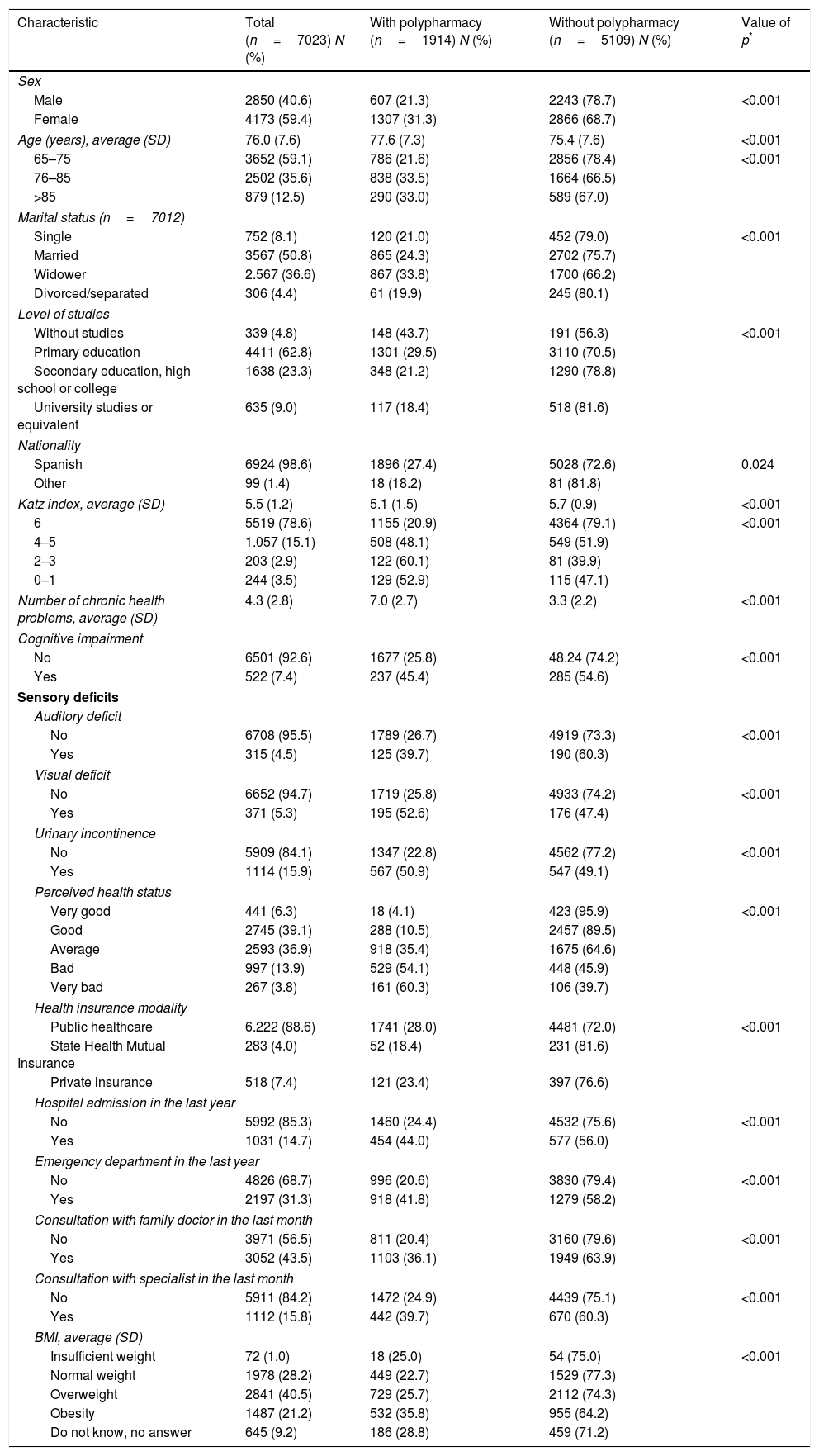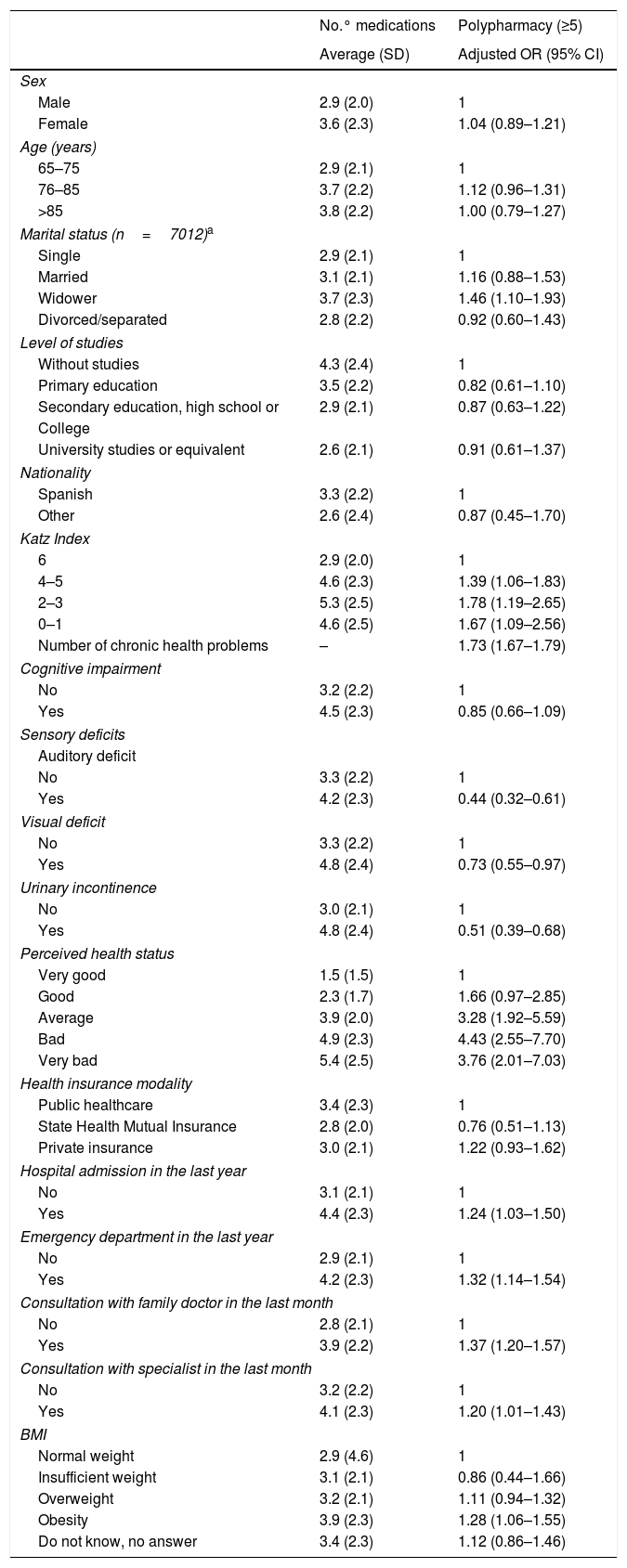To estimate the prevalence of polypharmacy and hyperpolypharmacy in non-institutionalised older adults in Spain and assess the associated factors.
Material and methodsA cross-sectional study based on data from the National Health Survey of Spain 2017, with participants aged 65 and over. The prevalence of polypharmacy (≥5 medications) and hyperpolypharmacy (≥10) were estimated, as well as the association with several factors through multivariate logistic regression. A sensitivity analysis was carried out considering the possible consumption of more than one drug for the same indication (polytherapy).
Results7023 participants were included, with a mean age of 76.0 (SD 7.6), 59.4% female and average consumption of 3.3 (SD 2.2) drugs per person. The prevalence of polypharmacy was 27.3% (95% CI 26.2–28.3) and of hyperpolypharmacy 0.9% (95% CI 0.7–1.1). The sensitivity analysis showed that the prevalence could be at least 37.5% and the average 3.9 (SD 2.5) when considering polytherapy. The factors most associated with polypharmacy were the number of chronic diseases, degree of dependence for the basic activities of daily living, self-perceived health or contacts with the health system; and negatively, sensory deficits and incontinence.
ConclusionsThe prevalence of polypharmacy in the elderly in primary care continues to increase and could be widely underestimated. In addition to multimorbidity, factors such as functional capacity or geriatric syndromes, fundamental in elderly people, modulate the habits of consumption and prescription of drugs in this population.
Estimar la prevalencia de polifarmacia e hiperpolifarmacia en adultos mayores no institucionalizados en España y analizar los factores asociados.
Material y métodosEstudio transversal a partir de datos de la Encuesta Nacional de Salud de España 2017, con participantes de 65 años o más. Se estimó la prevalencia de polifarmacia (≥5 medicamentos) e hiperpolifarmacia (≥10), y la asociación con diversos factores mediante regresión logística multivariante. Se realizó un análisis de sensibilidad considerando el posible consumo de más de un fármaco para la misma indicación (politerapia).
ResultadosSe incluyeron 7.023 participantes, con edad media de 76,0 (desviación estándar [DE] 7,6) años, 59,4% mujeres y consumo medio de 3,3 (DE 2,2) medicamentos por persona. La prevalencia de polifarmacia fue de 27,3% (intervalo de confianza del 95%: 26,2-28,3) y la de hiperpolifarmacia de 0,9% (intervalo de confianza del 95%: 0,7-1,1). El análisis de sensibilidad estimó que la prevalencia podría ascender al menos a un 37,5% y la media a 3,9 (DE 2,5) al considerar la politerapia. Los factores que más se asocian a la polifarmacia fueron el número de enfermedades crónicas, el grado de dependencia para las actividades básicas de la vida diaria, el estado de salud percibido o los contactos con el sistema sanitario; y de forma inversa los déficits sensoriales y la incontinencia.
ConclusionesLa prevalencia de polifarmacia en adultos mayores en atención primaria continúa aumentando, y podría estar ampliamente infraestimada. Además de la pluripatología, factores como la capacidad funcional o los síndromes geriátricos, fundamentales en personas mayores, modulan los hábitos de consumo y prescripción de medicamentos en esta población.
Artículo
Comprando el artículo el PDF del mismo podrá ser descargado
Precio 19,34 €
Comprar ahora












